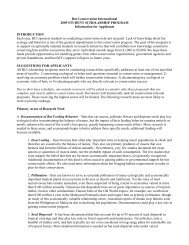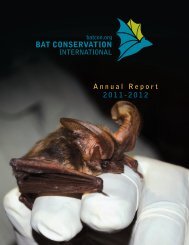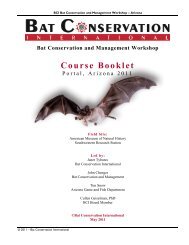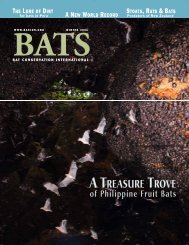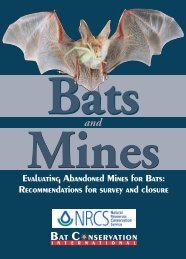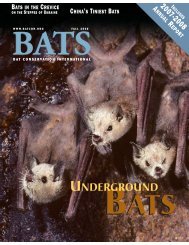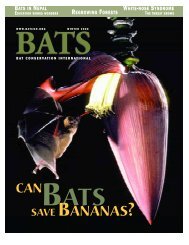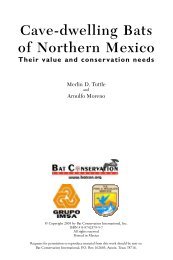Bat Echolocation Researc h - Bat Conservation International
Bat Echolocation Researc h - Bat Conservation International
Bat Echolocation Researc h - Bat Conservation International
Create successful ePaper yourself
Turn your PDF publications into a flip-book with our unique Google optimized e-Paper software.
108<br />
INTRODUCTION<br />
Much of our knowledge about bat ecology, behavior,<br />
and echolocation comes from studies conducted in the<br />
field. Owing to continuous technological improvements<br />
in equipment and an ever-increasing number of<br />
researchers, bat field ecology is a growing and yet still<br />
challenging area of research. In point, this symposium<br />
provides an overview of the current state in field-based<br />
bat echolocation studies. Another well of information<br />
for bat behavioral biologists are psychophysical experiments<br />
designed to investigate the performance and sensory<br />
capacities of echolocation systems. Often, a 2-alternative<br />
forced-choice paradigm is used in which a bat sits<br />
on a Y-shaped platform and crawls either onto the left or<br />
the right branch of the platform to indicate whether it<br />
perceives an object left or right. Such objects might be<br />
real targets like thin wires or virtual, so-called phantom<br />
targets (i.e., echoes modified by a computer and played<br />
back through a loudspeaker).<br />
Whereas field studies allow us to learn about the natural<br />
and complex behaviors of bats, they are limited by<br />
the difficulty of creating standardized experimental conditions<br />
that are necessary to answer many biological<br />
questions. In psychophysical tests, the experimental conditions<br />
can be controlled, and often reach a high level of<br />
sophistication. However, experiments with sitting rather<br />
than flying bats and highly specific, sometimes quite simplified<br />
psychophysical tasks (for the sake of experimental<br />
clarity) are different from a bat’s natural foraging situation,<br />
where it flies in 3-dimensional space and has to cope<br />
with complex echo scenes. In this paper, I discuss flightcage<br />
studies as a method to bridge the gap between field<br />
studies and psychophysical experiments. I outline the<br />
advantages of working with bats in a flight cage and then<br />
address more specifically the advantages and disadvantages<br />
of recording echolocation calls in a flight cage.<br />
Finally, I address the question of whether acoustic species<br />
identifications can be based on flight-cage recordings as<br />
a reference database.<br />
WHY WORK WITH BATS IN A FLIGHT CAGE?<br />
If one is interested in the study of hunting and associated<br />
echolocation behavior in bats in the field, one has<br />
to first know the natural foraging areas of the bats. This<br />
is feasible for bats who prefer a specific and delimited<br />
habitat type, such as the surface of calm water bodies.<br />
Not surprisingly, several detailed field studies report the<br />
prey-capture techniques and echolocation behavior of<br />
trawling Myotis species; those that capture insects from<br />
and at low heights above water surfaces (e.g., Britton et<br />
al.1997; Jones and Rayner 1988, 1991; Kalko and<br />
Schnitzler 1989). Likewise, bats that forage in open situations<br />
using echolocation calls with high sound-pressure<br />
level can, with considerable effort, be found,<br />
observed, and recorded in the field (e.g., Jensen and<br />
Miller 1999; Kalko 1995; Kalko and Schnitzler 1993).<br />
However, the natural hunting behavior of bats that<br />
habitually forage within or close to vegetation and who<br />
often use low sound-pressure level echolocation signals<br />
is difficult to see in the field. Even radio-tagged individuals<br />
are not easy to be directly observed (e.g., Arlettaz<br />
1999; Siemers et al. 1999). It is even more difficult to get<br />
close enough to obtain high-quality call recordings<br />
especially when the bats are actually capturing prey. For<br />
these species, flight-cage studies may provide a suitable<br />
approach to observe foraging behavior difficult to<br />
observe in the wild (e.g., Trachops cirrhosus (Phylostomidae):<br />
Barclay et al. 1981; Plecotus auritus (Vespertilionidae):<br />
Anderson and Racey 1991; Myotis sp.: Arlettaz et<br />
al. 2001; Faure and Barclay 1992, 1994; Siemers and<br />
Schnitzler 2000; Swift and Racey 2002).<br />
Most flight-cage studies focus on gleaning bats and<br />
on those which hunt in or close to vegetation. First, only<br />
anecdotal foraging observations are often obtainable for<br />
these species. Second, flight-cage studies closely emulate<br />
natural conditions for these kinds of bats. A flight cage is<br />
a restricted and echo-cluttered “habitat” from a bat’s point<br />
of view. To try and study prey capture behavior of open<br />
space foragers in such a restricted environment will not<br />
yield meaningful results. However, bats adapted to cluttered<br />
habitats should cope well with a flight-cage environment.<br />
They can be observed and experimentally tested<br />
while performing natural behaviors in this semi-natural<br />
setting. If necessary, flight cages can be equipped with<br />
habitat elements such as leaf litter, grasses, branches,<br />
small ponds, etc. (e.g., Arlettaz et al. 2001; Britton and<br />
Jones 1999; Siemers and Schnitzler 2000; Siemers et al.<br />
2001a, 2001b; Swift and Racey 2002).<br />
In a flight cage, it is also feasible to study behavior<br />
with a degree of detail difficult to achieve for animals in<br />
the wild. This, for example, applies to the study of the<br />
bats’ motor behavior during prey capture. Close-up photographic<br />
or video documentation can be used, as prey<br />
can be offered at a predefined location. Detailed behavioral<br />
documentation with sufficient sample sizes are relatively<br />
easy to obtain. For instance, the role of the tail<br />
membrane and feet during prey retrieval from the water<br />
surface by Myotis daubentonii was clarified in a flight cage<br />
(Britton and Jones 1999; Siemers et al. 2001a) complementing<br />
previous field observations (Jones and Rayner<br />
1988; Kalko and Schnitzler 1989).<br />
I referred to the difficulty of obtaining quantitative<br />
experimental data in the field although there are a range<br />
of excellent examples of experimental field studies<br />
assessing the sensory basis of food detection with wild<br />
bats (e.g., Barclay and Brigham 1994; Boonman et al.<br />
1998; Fuzessery et al. 1993; von Helversen and von Helversen<br />
1999). Two of these studies involved training wild<br />
trawling bats to forage in a defined experimental area,<br />
selecting and taking objects from the water surface. Von<br />
Helversen and von Helversen (1999) worked with flower-visiting<br />
glossophagine bats and experimentally<br />
manipulated their natural food resource, the inflorescences<br />
of the Neotropical liana, Mucuna holtonii. Where<br />
<strong>Bat</strong> <strong>Echolocation</strong> <strong>Researc</strong>h: tools, techniques & analysis




